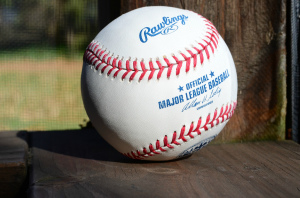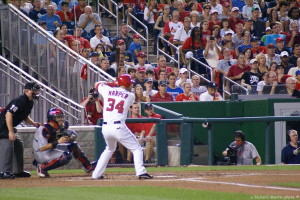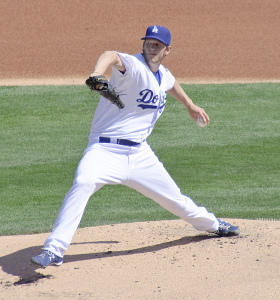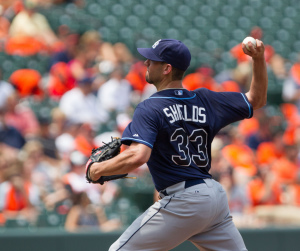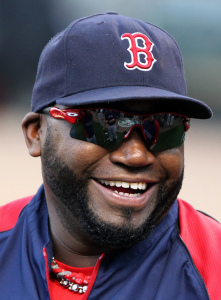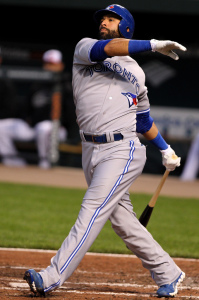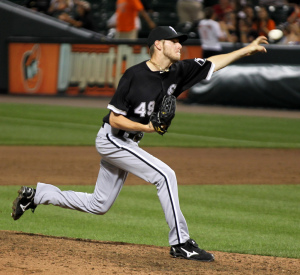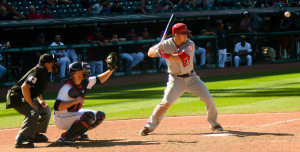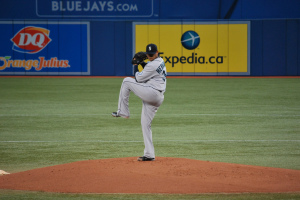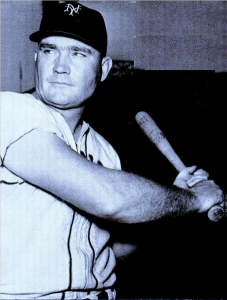With the players in camp and exhibition games approaching, BBRT is finishing up its 2015 pennant race predictions. This post will focus on the National League – for the BBRT take on the American league, click here. We’ll take a brief look at each divisional race and, for those who want a more detailed look, finish up with a team-by-team preview.
NL EAST
The Nationals ran away with the NL East a year ago (17 games over second-place Atlanta) and added the off-season’s premier free-agent – former Cy Young Award winner Max Scherzer. With arguably MLB’s best one-to-five starting rotation, Washington is poised to repeat. The Mets and Marlins are likely to fight it out for second place – and a possible Wild Card Spot. The Mets boast a strong starting rotation (particularly if Matt Harvey is back in form), an underrated bullpen and sound offense. Miami comes into the season with a strong offense, an effective bullpen and a combination of young and veteran arms in the rotation. While the Braves still have a solid pitching staff (and one of the game’s top closers), they traded away too much of their offense to contend. The Phillies are in the processing of rebuilding – and their fans will need patience. Predicted order of finish:
Washington Nationals
New York Mets
Miami Marlins
Atlanta Braves
Philadelphia Phillies
NL CENTRAL
The Cardinals should have just enough offense to ride their pitching to another division title – although it wouldn’t surprise BBRT to see the Pirates, Cubs or Brewers atop this division either. The Pirates, led by MVP-candidate Andrew McCutchen, have a nice balance of power, speed and defense in the lineup. The pitching is a bit worrisome, but if the rotation holds up, they will be in the race to the end. The Cubs improved on the field (Jon Lester, Jason Hammel, Miguel Montero) and in the dugout (new manager Joe Maddon). They also have a nice blend of veterans and up-and-coming youngsters in the lineup. They will contend and, if the Pirates falter in the least, Maddon should be able to lead the Cubs into second place. The Brewers led the division for 150 days in 2014, before a late season meltdown. A healthy Ryan Braun would boost their chances, but the starting pitching seems a little thin. While everyone else in the division seemed to be improving, the Reds appear to have given up more than they gained in the off-season market – particularly went it comes to the pitching mound. Predicted order of finish:
Saint Louis Cardinals
Pittsburgh Pirates (Wild Card)
Chicago Cubs
Milwaukee Brewers
Cincinnati Reds
NL WEST
The Dodgers have the best pitcher in baseball in Clayton Kershaw – and the best starting rotation in the West. Plus, Los Angeles made a host of (surprising) off-season moves, improving their defense, without diminishing the offense. They should repeat as division champs. We should see a battle for second place (and a Wild Card spot) between the defending World Series Champion Giants and the up-and-coming San Diego Padres. BBRT is going to go out on a limb and say the dramatically improved Padres offense (particularly the all-new outfield) and strong pitching will bring the Padres home ahead of the Giants. The Giants will still be in it, but they will miss Pablo Sandoval and Michael Morse, and they really could have used Jon Lester or James Shields to bolster their rotation. (BBRT had San Diego predicted to finish behind the Giants until the Shields signing.) The Rockies face the usual dilemma – solid offense (if healthy) and suspect pitching (Who wants to sign on to pitch at Coors?). Good health could help – the Rockies led the NL in trips to the disabled list in 2014 – but fourth place looks like the limit. On a winning team, the Diamondbacks’ Paul Goldschmidt would be one of the front-runners for MVP. While the D-backs did improve over the off-season, look for a middle-of-the-pack offense to be offset by a below-average pitching staff. Predicted order of finish:
Los Angeles Dodgers
San Diego Padres (Wild Card)
San Francisco Giants
Colorado Rockies
Arizona Diamondbacks.
NL MVP
Winner: Giancarlo Stanton, Miami Marlins
Contenders: Andrew McCutchen, Pirates; Anthony Rizzo, Cubs; Paul Goldschmidt, Diamondbacks.
NL CY YOUNG AWARD
Winner: Clayton Kershaw, Los Angeles Dodgers
Contenders: Max Scherzer, Nationals; Jordan Zimmerman, Nationals; Stephen Strasburg, Nationals; and, to break the trend, Johnny Cueto, Reds.
NL ROOKIE OF THE YEAR
Winner: Joc Pederson, Los Angeles Dodgers
Contenders: Yasmany Tomas, Diamondbacks; Noah Syndergaard, Mets; Jorge Soler, Cubs; Kris Bryant, Cubs.
___________________________________________________________________
Now, let’s look at the division races team-by-team.
NL EAST
First – Washington Nationals
No NL team won more games than the Nationals’ 96 in 2014 (and only the Angels in the American League topped that number with 98 wins). Had the Nats simply sat back and watched the off-season marketplace, Washington would have still been the favorite in the East. But the Nationals went out and got MLB’s most-coveted free-agent prize – Tigers right-hander Max Scherzer (18-5, 3.15, with 252 strikeouts). The 2013 Cy Young Award winner, who has a 70-24 record over the past four seasons, joins a 2015 rotation that will feature: Jordan Zimmerman, Stephen Strasburg, Gio Gonzalez (the only lefthander in the rotation) and Doug Fister. And, if any of these falter (or injuries surface), Tanner Roark (15-10, 2.85 for the Nats last season) is ready to step in. This rotation is clearly among the best (if not the best in baseball) and will keep Washington on top of the East.
The bullpen will miss key setup man Tyler Clippard (traded to the A’s for infielder Yunel Escobar), Ross Detwiler (traded to the Rangers) and free-agent Rafael Soriano. The Nationals still have closer Drew Storen (11 saves, 1.12 ERA) and also signed two former closers: Casey Janssen (81 saves for the Blue Jays over the past three seasons) and Heath Bell (who saved 40+ games in a season as recently as 2011). Also in line for relief work are Aaron Barrett, Matt Thornton and Craig Stammen. Overall, the bullpen could use some help, but the starting rotation should keep the pressure off.
The Nats lost an offensive and defensive asset in free agent Adam LaRoche (who hit 26 home runs and played plus defense at first base). Still there is plenty offense to support the National’s stellar pitching – a year ago the National gave up the fewest runs and scored the third-most runs in the NL. Former third-sacker Ryan Zimmerman should take over at first base. He has had shoulder problems (hence the position switch), but did hit .280 with five home runs in 61 games last season – and 26 home runs as recently as 2013. Even if Zimmerman doesn’t return to 2013 form, the Nationals can expect offensive punch from the likes of RF Bryce Harper (could this be the “breakout” year Nats’ fans have been waiting for), LF Jayson Werth and SS Ian Desmond – who will all benefit from the table-setting skills of CF Denard Span and 3B Anthony Rendon at the top of the order (the pair combined to score 205 runs and steal 48 bases in 2014).
Clearly, the National are favorites to capture the East – and will go as far in the post season as their rotation will carry them.
Key Question: Who will be the Opening Day starter – Max Scherzer, Stephen Strasburg or Jordan Zimmerman? Talk about an embarrassment of riches.
Nationals Fact: The Nationals were the only NL East team with a winning record in 2014 – taking their division by 17 games over the Braves.
Second – New York Mets
Meaningful September baseball is coming back to New York – and not at Yankee Stadium.
It all starts on the mound for the Mets – with a rotation likely to feature at least four of the following arms: NL Rookie of the Year Jacob deGrom (9-6, 2.69), Zack Wheeler 11-11, 3.94), lefty Jon Neise (9-11, 3.40), Dillon Gee (seven wins) and 41-year-old Bartolo Colon (who won 15 games for NY in 2014). But the final story of the effectiveness of the Mets rotation may be written by a pair of hurlers who did not take the mound for New York in 2014. The Mets are counting on a rebound from right-handed starter Matt Harvey – who sat out last season, following Tommy John surgery, after making the All Star team in 2013 (9-5, 2.27 in 22 starts). It’s also possible that prospect Noah Syndergaard may crack the rotation at some time during the season. In five minor league seasons, Syndergaard has gone 31-19, 3.25 and fanned 474 batter ion 426 2/3 innings. Interestingly (to BBRT), deGrom, Wheeler and Syndergaard are all right-handed throwers who bat left-handed.
The bullpen – while not boasting a host of big names – has the ability to get the job done. Closer Jerry Mejia notched 28 saves in 31 opportunities, and whiffed 98 batters in 93 2/3 innings. Jeurys Familia, who appeared in a team-high 76 games last season – with a 2.21 ERA and more than a strikeout per inning – should again get plenty of work. Others in the pen are likely to include Vic Black (2.60 ERA in 41 games) and Josh Edgin (1.32 in 47 games). The bullpen could also get a boost with the return of former closer Bobby Parnell (Tommy John surgery), who could challenge Mejia for the ninth-inning spot.
The Mets added some offense and veteran leadership with free-agent signee OF Michael Cuddyer. Cuddyer is a proven run-producer who hit .332-10-31 in an injury-shortened season (49 games) for Colorado. Cuddyer is one-year removed from a .331-20-84 season. While he may not do that kind of damage away from Colorado, a .280 average with 20-25 home runs is a reasonable expectation. There is more punch available from 1B Lucas Duda (.253-30-92) and second baseman Daniel Murphy provides a steady bat (.289) in the number-two hole. CF Juan Lagares showed a good glove and hit .281 (116 games) in the leadoff sport. Still, to challenge the Nationals, the Mets will need a rebound from veteran 3B David Wright, who is coming off a shoulder injury that sapped his power in 2014 (just eight home run in 134 games) and LF Curtis Granderson (.227-20-66 in 2014, but boasting a 40-home run season as recently as 2012). The new dimensions at Citi Field should help both. Behind the plate, the Mets would like to see the Travis d’Arnaud of the second half (.265 with seven home runs, as opposed to the first-half’s .217 with six homers.) It looks like a trip to AAA in June – where d’Arnaud hit .436 with six home runs in 16 games) may have resolved his offensive problems.
Key Question: Will either Wilmer Flores or Ruben Tejada step up and take over the shortstop spot?
Mets Fact: For 2015, the Mets are moving the right-field and right-center field fence in five-feet and ten-feet, respectively. If those dimensions had been in place in 2014, the Mets would have hit 17 more home runs and given up seven more.
Third – Miami Marlins
The Marlins signed MVP candidate RF Giancarlo Stanton (.288-37-105, with 13 steals) to 13-year $325 million contract – and then worked to build a contending team around him. The Marlins, in fact, were one of MLB’s busiest teams in the off-season. They did keep the outfield intact, and it’s one of the best – with Stanton joined by LF Christian Yelich (.284-9-54, 21 steals) and CF Martin Ozuna (.269-23-85). All three can hit and all three have Gold Glove potential. Miami revamped its infield, with the only holdover in the starting quartet being slick-fielding SS Adeiny Hechavarria, who hit .276 last season. The corner infield spots will feature trade acquisition 3B Martin Prado (.282 with 12 home runs for the Diamondbacks and Yankees) and free-agent signee 1B Michael Morse (.279-16-61 with the Giants). The Marlins also added some needed speed top the lineup, picking up 2B Dee Gordon (.289 with 64 steals) in a trade with the Dodgers. The Marlins could use a comeback year from C Jarrod Saltalamacchia, who slumped to .220-11-44 after .273-14-65 in 2013 – and also threw our only 17 percent of attempted base stealers.
The rotation will miss Jose Fernandez, who had Tommy John surgery last May and likely won’t be back until (or very near) the All Star break. In 36 MLB starts, The 2013 All Star and Rookie of the Year is 16-8 with a 2.25 ERA and 10.3 strikeouts per nine innings. In Fernandez’s absence, the number-one spot will temporarily go to Henderson Alvarez (12-7, 2.65). Rounding out the starting staff will be: veteran Mat Latos (trade with the Reds), a quality arm, but an injury risk; 13-game winner Jarrod Cosart; Tom Koehler (10-10, 3.81); and Dan Haren (trade with the Dodgers).
The bullpen will be led by closer Steve Cishek (39 saves, 84 whiffs in 65 1/3 innings), with quality support likely to come from Mike Dunn, Bryan Morris, A.J. Ramos, Aaron Crow (trade with Royals) and Carter Capps. (Crow, Morris and Ramos were a combined 21-2 a year ago).
The Marlins were big players in the off-season market – plugging some holes, adding a couple of starters to hold things down until Fernandez returns and even adding to an already solid bullpen. They should fight the Mets for second place in the East, but aren’t ready to topple the Nationals yet.
Key Question: When will Jose Fernandez return – and will Latos and Haren be able to fill the gap until he does?
Marlins Fact: In 2014, Giancarlo Stanton led the NL in intentional walks with 24. The next highest NL total was 12 (Jody Mercer, Pittsburgh/Chase Utley, Philadelphia).
Fourth – Atlanta Braves
In trading away Justin Upton, Jason Heyward and Evan Gattis, the Braves parted with just over half their 2014 home run production – 62 of 123). Atlanta also let a number of free agents depart, including pitchers Ervin Santana and Aaron Harang (who won a combined 26 games for the Braves a year ago) and Brandon Beachy and Kris Medlin (neither of whom pitched in 2013 – Tommy John surgery).
These off -season moves did not help an already weak offense. After scoring the second-fewest runs in the NL a year ago, the Braves may have taken a step backward with the Upton, Heyward and Gattis departures. Atlanta did add free agent Nick Markakis (.276-14-50 with the Orioles). That’s a pretty even exchange for Heyward in the OF – their offensive numbers are similar and they both captured Gold Gloves in 2014. The rest of the outfield picture does not look as rosy. Among the candidates are Jonny Gomes, Melvin Upton, Jr. (the artist formerly known as B.J. Upton) and Eric Young, Jr. – as well as rookies Todd Cunningham and Zoilo Almonte (18 home runs at Triple A). Gomes hit .234, with six home runs and 37 RBI for Boston and Oakland last year, while Upton put up a .208-12-35 line for the Braves – which, by the way, was an improvement over his 2013 stat line of .184-9-26. Young hit .229 in 100 games with the Mets, but did steal 30 bases. BBRT doesn’t expect a lot of offense from the Braves’ garden players. There is a little punch at the corner infield spots with returnees 1B Freddie Freeman (.288-18-78) and 3B Chris Johnson (.263-10-58). You expect more power form the corners and the good news is both Freeman and Johnson have shown they can do better. Shortstop will be handled by Platinum Glove winner Andrelton Simmons, but second base is remains unsettled until prospect Jose Peraza, a 21-year-old who hit .339 with 60 steals at High A and Double A in 2014, is ready. In the meantime, free-agent signee utility infielder Alberto Callaspo is likely to handle most of the keystone duties – but there is a chance Eric Young, Jr. could slide into the second base competition as well. Catching is in the hands of Christian Bethancourt (a fine defensive backstop) and free-agent signee A.J. Pierzynski, who can provide some offensive punch. Overall, it looks like the Braves will again have trouble putting runs on the board.
The pitching is in better shape – even with the offseason losses. The rotation will be led by Julio Teheran (14-13, 2.89) and southpaw Alex Wood (11-11, 2.78). Atlanta is also counting on the arms of newcomer Shelby Miller (10-9, 3.74 for the Cardinals) and returnee Mike Minor (a left-hander who had an off-season in 2014, but won 13 games the previous season). There should be competition for the number-five slot, with the most intriguing prospects being 2010 first-round draft pick Michael Foltynewicz (picked up in the Gattis trade) and ten-year veteran Wandy Rodriguez.
The bullpen should be a strong point, featuring flame-throwing Craig Kimbrel (47 saves), arguably the NL’s best closer, and free-agent signee Jason Grilli (who saved 12 games last season and 33 for the Pirates in 2013). The Braves are also hoping for a rebound from free agent Jim Johnson, who had a rough 2014 (5-2, 7.09 with the A’s and Tigers), but topped 50 saves in 2012 and 2013.
In 2014, the Braves had the NL’s third-best ERA – and the pitching looks solid again in 2015. Unfortunately, there doesn’t appear to be enough offense to translate the pitching into a .500 or better season.
Key Question: In his last two seasons with Tampa Bay, Melvin (then B.J.) Upton, Jr. hit .244, with 51 home runs, 159 RBI and 67 steals. In his first two with the Braves (2013-14), his totals were .198-21-61, with 32 steals. This season, Upton announced he would go from being known as B.J. Upton to his given name of Melvin Upton, Jr. The question is, will the “new” Melvin be able to live up to B.J.’s promise? The Braves’ offense needs more from the 30-year-old.
Braves Fact: In 2014, the Braves scored two or fewer runs in 64 games – 55 of them losses.
Fifth – Philadelphia Phillies
The Phillies finished last in the East a year ago – giving up the most runs and scoring the second fewest in the division – and yet the core of the team is remarkably similar for 2015. It would be foolish to expect a different result.
On offense, the key power spots – corner infield – are manned by returnees 35-year-old 1B Ryan Howard (.223-23-95, with an NL-leading 190 strikeouts) and 3B Cody Ashe (.252-10-44 in 121 games.) Ashe, however, may be pushed by power prospect Maikel Franco (16 HRs and 78 RBI at Triple A). Chase Utley, at 36-years-old, is back at 2B – after a .270-11-78 season. He will have a new double play partner (longtime SS Jimmy Rollins was traded to the Dodgers), most likely 25-year-old Freddy Galvis (who hit just .176 in 43 games for the Phils in 2014). Carlos Ruiz (.252-6-31) is back behind the plate. If the infield seems bereft of reliable power, the outfield doesn’t offer any relief. Gone via trade is Marlon Byrd (who led the Phillies with 25 home runs a year ago). Returning are: CF Ben Revere – an effective leadoff man who hit for a .306 average and stole 49 bases, but offers no power (his two home runs last year were the only round trippers of his 493-game career) – and RF Dominic Brown, who hit just .235 with ten home runs. Grady Sizemore is back and will compete (or platoon) for the LF spot with Darin Ruf. The pair hit .233 and .235, respectively last season).
We may see some changes before the season opens, but the rotation looks to be led by left-hander Cole Hamels – a legitimate “ace” who went 9-9 with a 2.46 ERA in 2014. Former Cy Young Award winner Cliff Lee (another southpaw) holds down the number-two spot, but he is 36-years old and coming off elbow issues. BBRT wouldn’t be surprised to see either Hamels or Lee on the trade market. After the front two, the Phillies are looking to free-agent signee Aaron Harang (a 12-game winner for the Braves, but also 36), veteran Jerome Williams (who pitched for Houston, Texas and Philadelphia last season) and either Dave Buchanan (6-8, 3.75) or free agent Chad Billingsley (attempting a comeback from elbow surgery).
Jonathan Papelbon (39 saves) will again handle the ninth inning, with notable bullpen support from Ken Giles (3-1, 1.18 in 44 games), Justin De Fratus (3-1, 2.39 in 54 games) and Jake Diekman (73 appearances, 100 strikeouts in 71 innings).
The Phillies just don’t have enough offense to compete in the East.
Key Question: Can former Rookie of the year and MVP Ryan Howard stay healthy and rebound offensively? From 2006 to 2011, Howard averaged 153 games, a .247 batting average, 44 home runs and 133 RBI per season. His averages from 2012-14 were 101 games, .231, 16 home runs and 65 RBI. A return to .250-30-100 territory would put a smile on a lot of Phillies’ faces.
Phillies Fact: On June 23, 1971, Rick Wise pitched a no-hitter for the Phillies, topping the Reds 4-0. Wise drove in three runs on a pair of homers – and is still the only pitcher to hit two home runs in a no-hitter. Wise, by the way, hit six home runs and drove in 15 runs that season. In 2014, the entire Phillies pitching staff hit zero home runs and drove in nine runs.
NL CENTRAL
First – Saint Louis Cardinals
The Cardinals will again have one of the NL’s top starting rotations. Adam Wainwright (20 wins), Lance Lynn (15 wins), John Lackey (14 wins for Boston and St. Louis) return to lead the rotation. They are joined by Michael Wacha, who had some shoulder issues, and put up a 5-6 record, with a 3.20 ERA in 19 starts. The final rotation spot appears slated for hard-throwing prospect Carlos Martinez – and, if he is not quite ready, youngster Marco Gonzalez and veteran Jaime Garcia (3-1, 4.12 in seven starts) could compete for the spot. The strength and depth of their starting pitching, in fact, enabled the Cardinals to trade reliable starter Shelby Miller (10-9, 3.74) to the Braves for OF Jason Heyward (more on that later).
Closing duties will continue to belong to Trevor Rosenthal (45 saves) – despite some control problems in 2014. The Miller trade also brought the Cardinals reliever Jordan Walden, who appeared in 58 games for the Braves, with a 2.88 ERA and 62 strikeouts in 50 innings. He adds depth to the bullpen and protection at closer (Walden saved 32 games for the Angels in 2011). Randy Choate, Sam Freeman and Seth Maness should also get plenty of work.
The Redbirds worked to improve their offense in the off season (last season, they hit the fewest home runs and scored the tent- most runs in the NL). The first order business was to replace the tragic loss (in an off-season car accident) of top prospect Oscar Taveras. In the Shelby Miller trade, the Cardinals picked up 25-year-old RF Jason Heyward (a Gold Glove defender, who went .271-11-58 with 20 steals for the Braves last season – and who many feel has yet to realize his full offensive potential). Heyward will join CF Jon Jay (who hit .303, but only three home runs) and LF Matt Holliday (a professional hitter who will deliver a .300 average with 20-homer power). In the infield, a pair of Matts (Adams and Carpenter) hold down 1B and 3B, respectively. Both are reliable defenders and solid run producers. The middle of the diamond belongs to Kolton Wong (2B) and Johnny Peralta (SS) – who delivered steady defense and 33 home runs between them. At catcher, they just don’t get any better than Yadier Molina – a six-time All Star and seven-time Gold Glover with a .284 career batting average. Finally, the Cardinals added some off-the-bench punch by signing free agent Mark Reynolds – who has hit 20 or more home runs in seven consecutive seasons, with a high of 44 in 2009. Reynolds, however, also strikes out A LOT and hit only .196 in 2014. He can fill in at 1B, 3B and, in a pinch, OF, as well as provide a pinch-hitting threat.
Overall, the Cardinals – while aging a bit – have enough to repeat at the top of the Central.
Key Question: Not too many questions on a well-balanced team. If there is one, it’s whether Michael Wacha’s arm (shoulder) holds up for the long haul?
Cardinals Fact: The Cardinals’ put the bat on the ball in 2014, striking out an NL-low 1,133 times.
Second – Pittsburgh Pirates
When your offense stars with 2013 MVP, four-time All Star and Gold Glove (2013) defender Andrew McCutchen, you can expect good things. The five-tool player went .314-25-84, with 18 steals in 2014 – pretty much an average year for him. Batting behind “Cutch” will be likely clean-up hitter 2B Neil Walker – a switch hitter, who hit .271 with 23 home runs in 2014. Flanking McCutchen in the OF will be Starling Marte (.291 with 13 homers) and Gregory Polanco (.235 with seven home runs and 14 steals in 89 games). Both Marte and Polanco are plus defenders and both are expected to continue to advance offensively. SS belongs to Jody Mercer, a solid defender who contributed 12 home runs, while the corner spots will be manned by 1B Pedro Alvarez (moving over from third base) and 3B Josh Harrison, a surprising .315 with 13 homers and 18 steals a year ago. Harrison gets the full-time nod at the hot corner after spending time at second, third, shortstop, left field and right field a year ago. His presence in the lineup and the acquisition of utility man Sean Rodriguez form Tampa Bay give Pittsburgh tremendous flexibility. Francisco Cervelli, acquired from the Yankees, will get a shot at the number-one catching slot after hitting .301 in 49 games last year, but he has health concerns and the Pirates will use Chris Stewart, who hit .294 in 49 games for the Pirates, as a backup on a regular basis. The pair will have big shoes to fill – replacing free agent Russell Martin (a key part of the Pirates’ recent success), who signed with the Blue Jays in the off season.
The Pirates have a nicely balanced line-up – power, speed and solid defense. The pitching has potential – the potential to be very good or to cause problems. Gerrit Cole is secure at the top of the rotation. The 24-year-old went 11-5, 3.65, striking out a batter an inning in 22 starts. Next in line is left-hander Francisco Liriano (7-10, 3.38) – a veteran with great stuff, but a history of inconsistency and injury problems. Free-agent signee A.J. Burnett is also expected to take a regular turn, but he is 38-years-old and lost 18 games last year (albeit with the Phillies). Prior to 2014, Burnett had run off nine straight seasons with at least ten victories. The final two rotation spots appear earmarked for Vance Worley and lefty Jeff Locke (who went a combined 15-10 in 39 starts for the Pirates last season). Worley could surprise. He went 8-4, 2.85 after starting the season at Triple A. The Pirates’ rotation could get a boost with the return of Charlie Morton (hip surgery last September)/
The bullpen will again be strength, led by closer Mark Melancon (1.39 ERA, 33 saves). Tony Watson (10-2, 1.63) made the All Star team as a setup man last season, John Holdzkom has flashed a 100-mph fastball and Jared Hughes (7-5, 1.96) is solid. Other bullpen assets could include Antonio Bastardo, and Stolmy Pimentel.
The Pirates will contend again and, if the starting pitching holds up, could knock the Cardinals off the top of the Central,
Key Question: Can the Pirates expect Pedro Alvarez to return to his 30+ home run production of 2012 and 2013? Alvarez hit only 18 homers last year, in a season that saw defensive concerns lead to a move from 3B to 1B and an injury limit him to 122 games.
Pirates Fact: 3B Josh Harrison hit an NL-leading .372 with runners in scoring position in 2014.
Third – Chicago Cubs
Cubs win! Cubs win! Cubs win! They’ll be hearing a lot more of that at Wrigley Field this season – as the Cubs parlay proven All Stars like Anthony Rizzo and Starlin Castro, emerging youngsters like Jorge Soler and Kyle Hendricks, free-agent pickups like Jon Lester and Jason Hammel, trade acquisitions like Miguel Montero and Dexter Fowler, and new Manager Joe Maddon into a contending ball club. Yes, the Cubs – like the White Sox – were busy in the off-season, and Chicago fans could see post-season baseball on both sides of the city.
Let’s start with the rotation. Free–agent signee southpaw Jon Lester should take the ball on Opening Day. Lester went 16-11, 2.46 for Oakland and Boston a year ago, but more important, he has won at least 15 games six times in the past seven season. He gives the Cubs a true “ace.” The Cubs may have a second ace-in-waiting in Jake Arrieta (10-5, 2.53 in 25 starts). To round out a solid rotation, they brought back free agent Jason Hammel and have 2013 rookie sensation Kyle Hendricks (7-2, 2.46 in 13 starts for the Cubs). There will be a battle for the fifth spot, probably among Edwin Jackson, Travis Wood and Jacob Turner – all of whom have something to prove after off seasons in 2014.
Roles are still being sorted out in the bullpen, but it appears closing duties will go to Hector Rondon (29 saves). Free agent signee Jason Motte is further removed from Tommy John surgery (2013) and may be closer to the pitcher that recorded 42 saves for the Cardinals in 2012. Motte could be a key contributor in 2015. Neil Ramirez (1.44 ERA), Pedro Strop (2.21), and Justin Grimm (3.78) all took the mound at least 50 times last season.
The offense starts with proven performers 1B Anthony Rizzo (.286-32-78) and SS Starlin Castro (.292-14-65). There are also LF Chris Coghlan (.283-9-41) and newly acquired CF Dexter Fowler (.276-8-35 with the Astros). After that, the Cubs are looking for production out of a group of highly touted youngster. Early 2015 Rookie of the Year candidate Jorge Soler should handle RF after going .292-5-20 in 24 games during a 2014 call up. They also hope for good things from 2B Javier Baez, who showed some power in 2014 (nine home runs in 52 games), but needs to develop plate discipline and patience (.169 average, 95 strikeouts in 213 at bats). If he’s not ready Tommy La Stella, who hit .252 for the Braves, could step in. Over at third base, the fans – and front office – are waiting for top prospect Kris Bryant, who hit 43 home runs and drove in 138 in 138 games at AA and AAA a year ago. If Bryant’s not quite ready, Luis Valbuena gave the Cubs 16 home runs from the hot corner in 2014. Catching belongs to 2014 All Star Miguel Montero, acquired in a trade with Arizona.
This is a good looking Cubs team, poised to contend not just for this year, but down the road. It wouldn’t surprise me to see them take a Wild Card spot or even the division title – particularly if Kris Bryant is “Ready for Wrigley.” Ultimatley, though, the young Cubbies – Soler, Baez and Bryant – may need another year of experience to Chicago over the top.
Key Question: What can the Cubs expect out of Javier Baez – and how much patience to they have? Can he harness his swing and reduce his strikeouts? If so, 35 home runs are not out of the question. If not, 200 strikeouts are equally in play. (BBRT note: The Cubs had 21-year-old shortstop Addison Russell – considered one of baseball’s top prospects – spending time at second base in the Arizona Fall League.)
Cubs Fact: No team struck out more often than the Cubs in 2014 – a club record 1,477 times.
Fourth – Milwaukee Brewers
Who are the Brewers? The team that was in first place by 6 ½ games (17 games over .500) on August 17 – or the team that faded at the end and finished just two games over .500 and out of the playoffs? BBRT’s guess is that it’s somewhere in between and that the Brewers will be competitive in 2015 – but not in the playoffs.
Milwaukee fans have the joy of watching energetic CF Carlos Gomez lead off every game. Last season, the Brewers’ sparkplug turned in a .284-23-73 stat line, with 34 steals and 95 runs scored. He gives the fans everything they expect (and more) from a top-of-the-order catalyst. In 2014, however, Milwaukee fans did not get all they expected from RF Ryan Braun. A thumb injury hampered him most of the season and he finished .266-19-81. The Brewers need Braun to get back to the player who routinely delivered 30 home runs and 100 RBI per campaign. The Brewers anticipate steady production from 3B Aramis Ramirez (.285-15-66), new first baseman Adam Lind (.321 for Toronto) and solid defensive backstop Jonathan Lucroy (.301-13-69). Khris Davis delivered some power form left field (22 home runs) and 2B Scooter Gennett hit .289 in 137 games. The Brewers could use a rebound from SS Jean Segura, a 2103 All Star who slumped offensively
While the offense seems to have offer enough positives – particularly if Braun and Segura bounce back – the pitching offers some concerns. With number-one starter Yorlando Gallardo gone in a trade with the Rangers, the Brewers rotation seems to come up a little short. BBRT side note: One of the young players the Brewers received in the Gallardo trade was SS prospect Luis Sardinas, which may reflect their concern with Segura’s future. Wily Peralta 17-11, 3.53), Kyle Lohse (13-9, 3.54) and Matt Garza (8-8, 3.64) are the “locks” among the starting staff. Matt Fiers looked good in ten starts last season, and would seem to have the edge for the fourth spot. Key competitors for the final berth would include Jimmy Nelson and Taylor Jungmann.
The bullpen starts with closer Francisco Rodriguez, who re-signed with the Brewers in late February. Rodriguez saved 44 games for the Brew Crew in 2014. Jonathan Broxton (seven saves for Cincinnati/Milwaukee a year ago – 27 saves as recently as 2012) should be the main setup man. Candidates for important roles in the pen include: Jeremy Jeffress, Will Smith, Brandon Kintzler and Jim Henderson.
While the Brewers have a potentially potent offense, there are concerns about both the back of the rotation and the bullpen. They could surprise, but it would be a surprise. Remember though, with a similar roster, they did lead the division for much of 2014.
Key Question: Is Ryan Braun healthy (thumb) and what does that mean for his production?
Brewers Fact: The Brewers were 15 games over .500 (70-55) with a three-game lead on August 17, but went 12-25 the rest of the way to finish 82-80 and out of the playoffs.
Fifth – Cincinnati Reds
Johnny Cueto (20-9, 2.25) and Aroldis Chapman (36 saves, 106 strikeouts in 54 innings). That’s a pretty good start to any pitching staff. Unfortunately, that pair can’t pitch all the innings, and the Reds are short on proven pitching depth – a situation they didn’t help by trading starters Mat Latos and Alfredo Simon in the off season. Looking at the rotation, the number-two and number-three spots look to go to Homer Bailey (9-5, 3.71, coming off September elbow surgery and possibly not ready on Opening Day) and Mike Leake (11-13, 3.70). After that, things are even less certain, but leading candidates seem to be newcomer Anthony DeSclafani (acquired form the Marlins), Dylan Alexrod (who looked good in a 2014 call up), left-hander Tony Cingrani and Cuban signee Raisel Iglesias.
Aroldis Chapman stands tall as the closer, but the rest of the bullpen suffered from injury and inconsistency in 2014. Despite Chapman’s 2.00 ERA, the Reds’ pen had a 4.11 ERA in 2014 – the NL’s second worst. Among candidates for the pen: Burke Badenhop (2.29 in 70 appearances for Boston), Pedro Villarreal, Sam LeCure, Jumbo Diaz and Manny Parra, The Reds also signed veteran Kevin Gregg (coming off elbow issues) to a minor league contract. Gregg – a 12-year MLB veteran – has 177 career saves. Competition for bullpen spots seems wide open.
The Reds have the potential for a solid offense – starting with corner infielders 1B Joey Votto and 3B Todd Frazier (29 home runs). They need a full season from Votto, who played only 62 games (.255-6-23) last season due to a knee injury. A healthy Votto should deliver 25+ round trippers. The Reds get added punch from All Star C Devin Mesoraco, who hit 25 home runs in 114 games, but had a pair of stints on the disabled list. Newcomer OF Marlon Byrd acquired from the Phillies) also brings 25-homer power to the lineup. Byrd should handle left field with RF going to Jay Bruce (who needs to rebound from a knee injury and his worst season ever) and CF stays with exciting speedster Billy Hamilton (56 steals). While Bruce hit just .217-18-66 last season, he has proven capable of 30+ homers and 90+ RBI when healthy. The Reds are strong defensively up the middle, with Zack Cosart at SS and Brandon Phillips at 2B. They are paying for that defense with offense, however. Cosart hit just .221 a year ago, while Phillips’ offensive production has been on the decline since his .288-30 home run-32 stolen base season in 2007. In 2014, Phillips hit .266 with eight home runs and two stolen bases.
Given the competitiveness of the Central Division – and the Reds’ pitching uncertainties, fifth place seems a realistic prediction.
Key Question: Can the Reds’ keep Billy Hamilton fresh? Hamilton got off to a great start in 2014, hitting .285 with 38 steals before the break, but seemed to wear down – hitting .200 with 18 steals after the break and only .123 with 2 steals in September. The Reds need a full season of the high-energy Hamilton.
Reds Fact: Despite finishing ten games under .400, the Reds defense had the best fielding percentage in MLB in 2014 (.988) and committed the fewest errors (72, ten fewer than runner up Seattle).
NL WEST
First – Los Angeles Dodgers
Wow! What happened? The Dodgers won the West again in 2014 – and then traded Matt Kemp and Dee Gordon and let free agent Hanley Ramirez walk. Notably, those moves were consistent with a long-standing Dodger tradition of winning with an emphasis on pitching and defense.
Up the middle, newcomers (acquired through trades) SS Jimmy Rollins and 2B Howie Kendrick should improve the reliability of the defense – and still provide adequate offense. Rollins hit 17 home runs and stole 28 bases for the Phils last year, while Kendrick hit .293 with seven homers and 14 steals for the Angels. The Dodgers will miss Gordon’s 64 steals, but Rollins/Kendrick should provide comparable offense. The trading of Kemp (287-25-89) removed some pop from the lineup, but helps clear an OF logjam. For 2015, we can expect to see an OF (improved defensively) of RF Yasiel Puig (.296-16-60), LF Carl Crawford (.300-8-46 and 16 steals in 105 games) and rookie Joc Perderson in CF. Pederson hit .303 with 33 home runs and 30 stolen bases (plus, importantly, 100 walks) in 121 games at AAA in 2014. Even after trading Kemp, the Dodgers have depth in the OF, with Scott Van Slyke and Andre Ethier on the bench. Rounding out the lineup will be Adrian Gonzalez (a four-time Gold Glove winner who can deliver 25-30 home runs) and 3B Jose Uribe (who hit .311 in 2014). Catching duties will be split between Yasmani Grandal and A.J. Elllis. The fact is, the Dodgers improved their defense in the off season and the offense – particularly if Joc Pederson meets expectations – should not miss a beat.
Improved defense will only make the Dodgers superior pitching even better. It all, of course, starts with Cy Young/MVP winner Clayton Kershaw (generally agreed upon as the best pitcher on the planet). We don’t need to cite statistics here –they’re almost legend already. Behind him is Zack Grienke (17-8, 2.71), who would be the ace on most staffs. The three-spot goes to under-recognized Hun-Jin Ryu (14-7, 3.38). Then it gets a little dicey, as the Dodger are counting on a free-agent signees Brandon McCarthy and Brett Anderson – who have both been injury prone in the past.
In the bullpen, incumbent closer Kenley Jansen (44 saves) will likely miss the first month of the season (foot surgery). There are plenty of hurlers to audition for temporary replacement status including former closers Brandon League (72 saves since 2011), and J.P. Howell (17 saves for Tampa Bay in 2009). Other options include hard- throwing Chris Hatcher and reliable Joel Peralta, both picked up in off season trades. Once a closer is selected the bullpen roles should take shape. It’s a bit unsettling, but not unworkable.
Key Question: Who will fill the closer’s role until Kenley Jansen returns?
Dodgers Fact: The Dodgers hold the MLB franchise record for no-hitters at 22 – with Josh Beckett and Clayton Kershaw contributing no-no’s in 2014.
Second – San Diego Padres
In 2014, the San Diego Padres finished third in the West (77-85) despite scoring the fewest runs (535) in the NL (in MLB, actually). How did they do it? The Padres gave up the second-fewest runs in the NL (523) and only the Nationals in the NL bested their team ERA of 3.27. Going into the 2015 season, the Padres actually improved that sterling pitching – the addition of premium free agent James Shields – and dramatically added to their offensive punch. They are ready to contend. BBRT is ready to go out on a limb and pick the Padres to finish ahead of the defending World Series Champion San Francisco Giants.
On the mound, veteran free-agent signee James Shields (14-8, 3.21 for the Royals) will not only be the staff ace on the field, he will also provide the kind of veteran leadership that will make the Padres’ young staff even better. Shields joins a rotation that should include Andrew Cashner (5-7, 2.55 in 19 starts), All Star Tyson Ross (13-14, 2.81), and veteran innings-eater Ian Kennedy (13-13, 3.63). The final spot in the rotation is likely to go to Odrisamer Despaigne (4-7, 3.36) or free-agent signee Brandon Morrow. Cashner has proven to be an injury concern in the past, so both Despaigne and Morrow may see time in the rotation. The Padres also signed free agent starter Josh Johnson – who missed the 2014 season after undergoing Tommy John surgery. Johnson, who has a career 58-45, 3.40 record over nine seasons, is expected to be back in late May of early June – and could give San Diego a mid-season boost.
The bullpen – and manager Bud Black’s ability to get the most out of it – will be a Padres’’ strength again (an NL-best 2.73 bullpen ERA in 2014). Closer Joaquin Benoit notched 11 saves with a 1.49 ERA – but is 37-years-old and did miss time with a shoulder injury last year. In Benoit’s absence, set up man Kevin Quackenbush picked up a handful of saves plus one (six total). Also in the pen are Alex Torres, Nick Vincent, Dale Thayer and Shawn Kelly (trade with Yankees).
While Shields represents a notable improvement in the pitching, the offensive upgrade is far more remarkable. Trades with the Rays, Braves and Dodgers give the Padres an all-new – and much more explosive –outfield. Left field now belongs to former Brave Justin Upton ( .270-29-102), center goes to former Ray Wil Myers (2013 AL Rookie of the Year, who missed time with a wrist injury and hit six homers with 35 RBI last season) and former Dodger Matt Kemp (.287-25-89) will hold down right. How much of an improvement is that? Last season’s three most often used starters in the Padres’ outfield – Seth Smith, Will Venable and Cameron Maybin – combined for fewer home runs and RBI (21-96) than Upton alone. Around the infield, we should see Yonder Alonso (1B), Jedd Gyorko (2B), Alexi Armarista (SS) and Yangervis Solarte or Will Middlebrooks (3B). Gyorko is a key piece. The second sacker hit .210 with just 10 home runs last season – after a .249, 23-homer season as a rookie in 2013. A rebound to 15-20 round trippers would further boost the Padres’ offense. Third base will be a competition between Solarte (.260 with 10 home runs as a rookie) and Middlebrooks, whom the Padres hope can rebound from an off season. Newcomer Derek Norris will handle the catching. All in all, the changes should not only improve the Padres on the field, but also bring a new, more confident, attitude to the club house.
The Padres look greatly improved and ready to move up to second place.
Key Question: Will the new outfield deliver offense as expected, or will pitcher-friendly Petco Power sap their power and confidence?
Padres Fact: In 2014, fewer home runs were hit in Petco Park (101) than any other MLB park
Third – San Francisco Giants
The Giants have won three World Series titles in the last five years (2010-2012-2014), so no one could blame the defending world champions if they opted for stability in the off season. And the Giants HAVE been pretty quiet since October. They did lose a key player – and part of the club’s character – when free agent Pablo Sandoval (.279-16-73 and .429 in the World Series) signed with the Red Sox. San Francisco will also miss OF Michael Morse’s nearly identical production (.279-16-61). But they did go out and pick up replacements for both. They added 3B Casey McGehee (trade with the Marlins), last year’s NL Comeback Player of the Year, to replace Sandoval. McGehee (four home runs) has less power than Sandoval, but did hit .287 with 76 RBI. (BBRT note: McGehee will also represent a step back on defense.) Nori Aoki (free agency, Royals) will take Morse’s spot on the roster. Like McGehee, less power, but a steady bat (.285 with 17 steals in 2014). The rest of the lineup is pretty much intact, not a bad thing after a World Series win (unless, of course, your main opposition improves). For power, the Giants will look to C Buster Posey (.311-22-89), reliable and energetic RF Hunter Pence (.277-20-74, with 13 steals)and 1B Brandon Belt – a slick defender, who hit the disabled list three times last season, but still managed 12 home runs in 61 games. A healthy Belt should provide 20-HR power. CF Angel Pagan (.300 with 16 steals in 96 games) should lead off. Pagan, however, has been injury prone and, in his absence, we could see Aoki at leadoff and backup George Blanco and Juan Perez (both solid defenders) in the OF. Joe Panik (who took over 2B in June, defending ably and hitting .305 in 73 games) is back, as is shortstop Brandon Crawford, who has a high ceiling, but needs to add consistently to his game in the field and at the plate.\
Not much has changed on the mound either, where the rotation will be led by World Series’ hero Madison Bumgarner (18-10, 2.98). After that there is considerable potential – but just as many question marks. Matt Cain, All Star and 16-game winner as recently as 2013, had elbow surgery in July and finished 2-7, 4.18. Jake Peavy pitched well after coming over from Boston (6-4, 2.17), but was 1-9 with the Sox. Tim Hudson won nine games and pitched well (3.57), but turns 40 in July. Ryan Vogelsong made a career-high 32 starts, but won only eight times (but did win 27 games in 2011-12). Tim Lincecum, despite a 12-9, 4.74 record was inconsistent last season and is now four seasons away from his last winning record.
In the bullpen, the Giants will look to Santiago Casilla (19 of 23 in save situation after taking over the ninth-inning job in mid-season). Also returning are Sergio Romo, who lost the closer job, but then straightened out and did fine as a setup man in the second half; Yu Petit, who proved considerably more effective as reliever (1.84 ERA) than a starter (5.03); Jean Machi; Javier Lopez; and Jeremy Affeldt. Ultimately, the bullpen should be a strength for the 2015 club.
It’s hard to argue with success – three World Series titles in five years. However, those titles all came in even-numbered years. This is an odd-numbered year, and while the roster has been pretty stable, issues with the starting rotation and roster improvements in Los Angeles and San Diego seem likely to keep the Giants out of the playoffs.
Key Question: How much will the Giants miss Kung Fu Panda’s (Pablo Sandoval) bat, glove and attitude – on the field, in the club house and at the ticket counter?
Giants Fact: The Giants won the first-ever regular-season interleague game, beating the AL’s Texas Rangers 4-3 on June 12, 1997. Mark Gardner got the win, Rod Beck the save and RF Stan Javier the game-winning RBI. Lead-off hitter CF Darryl Hamilton singled on a 1-1 offering from the Rangers’ Darren Oliver in the first inning to get the first-ever interleague hit. Javier also had interleague play’s first home run.
Forth – Colorado Rockies
As usual, the Colorado Rockies seem to have plenty of offense – and the kind of pitching that mandates they’ll need it. The Rockies finished 30 games under .500 a year ago – and had MLB’s worst team ERA at 4.84, while leading the NL in runs scored. Still, the losses weren’t all about the pitching. The Rockies also led the majors in player trips to the disabled list (26). They didn’t do much in the off-season (in fact, the most meaningful off-season change may have been the departure of RF Michael Cuddyer). Colorado is counting on better health to lead to a better record.
At Coors field, it all starts with offense – and, when healthy, the Rockies have plenty of it. SS Troy Tulowitzki and CF Carlos Gonzalez need to lead the way. The pair were both hit by the injury bug and played a combined 161 games a year ago – putting up 35 home runs and 90 RBI. Healthy, they can put up double that production – and they are both solid defenders. Keys to the offense also include CF and lead-off man Charlie Blackmon (.282 with 19 home runs, 82 runs scored, 72 RBI and 28 steals); former AL MVP , 2014 NL Batting champ and plus defender Justin Morneau (.319-17-82) at 1B; and Gold Glover Nolan Arenado (.287-18-61 in 111 games – finger fracture) at 3B,. LF Corey Dickerson surprised a few people by hitting .312 and leading the Rockies in home runs with 24 in just his second MLB season. Dickerson’s emergence makes Drew Stubbs a valuable fourth outfielder – especially given the Rockies’ injury history. In 2014, Stubbs hit .289 with 15 home runs. Second baseman DJ LeMahieu’s contributions get lost in the Rockies’ offensive fireworks (he hit just .267), but he’s the NL’s 2014 Gold Glove winner at 2B. The Rockies added more defense when they picked up free-agent catcher Nick Hundley – a solid defensive catcher and game caller. Wow, plenty of offense, sound defense – sounds pretty good so far.
When it comes to pitching – the key word in Colorado is “Ouch!” The injury bug and the Coors Field atmosphere both worked against the Rockies’ staff in 2014, and the end result was the NL’s highest ERA – both among starters and relievers. That does not win many ball games. The rotation is Jorge De La Rosa (14-11, 4.10 and a surprising 10-2, 3.08 in his Coors Field innings). After De La Rosa, there is a notable drop off. Jhoulys Chacin should be the number-two man, but was limited to eleven 2014 starts (1-7, 4.50) due to rotator cuff issues. If healthy, he could return to his 14-10, 3.47 form of 2013. The Rockies did sign Kyle Kendrick, who won ten games for the Phillies a year ago, and he could slide into the number-three sport. Others in the running for the rotation are Jordan Lyles (7-4, 4.33, who missed time due to a broken bone in his non-pitching hand); Tyler Matzek (6-11, 4.05); Charlie Bergman (3-5, 5.93) and prospect Eddie Butler. We may see Colorado auditioning starters into the season. Last year, the team used 15 different starters.
The bullpen should see plenty of work once again. LaTroy Hawkins saved 23 games in 26 opportunities, but he is 42-years-old. The Rockies are hoping for better things from reliever Boone Logan (6.84 ERA) and Rex Brothers (5.59). There is hope. Logan is one more season removed elbow surgery and was 5-2, 3.23 in 2013, while Brothers (once considered a closer-in-waiting) had a 2.82 career ERA going into 2014. Tommy Kahnle, Adam Ottavino and Brooks Brown are also expected to find spots in the bullpen,
All in all, the Rockies – if healthy, have plenty of offense and solid defense to improve on their record – especially if the pitching staff can induce ground balls at Coors. Ultimately, however, they will need to add pitching to make win enough games to contend.
Key Question: How long can 42-year-old LaTroy Hawkins keep getting batters out?
Rockies Fact: No pitcher likes Coors Field more than Jorge De La Rosa. He is 45-14, 3.98 for his career in the hitters’ paradise. (His overall career record 84-68, 4.60)
Fifth – Arizona Diamondbacks
The Diamondback finished last in NL West last year and they did do some work on their problem areas in the off season. Arizona had the league’s second-worst ERA (only the Rockies and Coors Field – finished worse). They set about to fix that – trading away C Miguel Montero, SS Did Gregorius and P Wade Miley – and picking up a handful of hurlers, including at least three likely to be in the 2015 rotation. They also looked to the offense – signing international free agent Cuban Yasmany Tomas. The 24-year-old was signed to a six-year, $68.5 million contract and is expected to bat in the middle of the lineup and provide a solid power source for the D-backs. (In his last three seasons in the Cuban National Series, Tomas hit .293, with 40 home runs and 137 RBI in 215 games.) Tomas should provide a boost to D-backs, who hit the NL’s third-fewest home runs a year ago.
Let’s look at the rotation. At the top will be Jason Collmenter (11-9, 3.46), whose fastball tops out in the high 80s, but who manages to keep hitters off balance. That contrasts with newcomer Rubby De Le Rosa (gotta love that name), who has been known to hit triple digits with his heater, but is also coming back form 2012 Tommy John surgery. De Le Rosa was 4-8, 4.43 in 19 games for the Red Sox in 2014. Jeremy Hellickson (AL Rookie of the Year in 2011) should also be in the mix. He logged double-digits in victories and at least 29 starts and 170+ innings per year for Tampa Bay for three years (2010-13), before surgery to remove bone chips held him to 13 starts and one victory in 2014. Allen Webster is another newcomer who should be in the D-backs’ rotation. He was 5-3, 5.03 for the Red Sox and 4-4, 3.10 at Triple A last season. Webster is a hard-thrower who needs to harness his control. Competing for the number-five spot will be returnees Victor Nuno, Chase Anderson and Trevor Cahill. Anderson went 9-7, 4.01 in 21 starts last year, but Nuno may be the most interesting candidate. The southpaw went 0-7 in 14 starts after coming over from the Yankees – but averaged six innings per outing and put up a 3.76 ERA. Pat Corbin, an All Star and 14-game winner in 2013, is returning from Tommy John surgery could provide a boost in the second half.
Arizona will depend on Addison Reed (32 saves) to close games. Getting to Reed will be the responsibility of (among others) side-armer Brad Ziegler (5-3, 3.49 in 68 games); Evan Marshall (4-4, 2.74 in 57 games); and former starter Oliver Perez (3-4, 2.91 in 68 games). The numbers at the top of the pen look okay, but overall Arizona had the third-worst NL bullpen ERA last year and the second–worst ratio of saves to save opportunities.
The lineup has offensive potential – starting at the corners with Yasmany Tomas, expected to provide plenty of power at 3B, and 1B Paul Goldschmidt (back in the heart of the order and healthy). Goldschmidt put up a .300-19-69 line, with nine steals, in just 107 games (fractured hand). In 2013, Goldschmidt went .302-36-125, with 15 stolen bases (and a Gold Glove). Expect him to be a force in 2015. BBRT sees an MVP Award somewhere in Goldschmidt’s future. Other power sources include RF Mark Trumbo (a free swinger who delivered 14 home runs – and 89 strikeouts – in 89 games) and LF David Peralta (.286, with eight home runs in 88 games as a rookie). The Diamondbacks also look set at the leadoff spot with CF A.J. Pollock, who was on a tear (.302-7-24, with 14 steals in 75 games), before a broken hand cost him more than half the season. The middle of the infield (2B-SS) will be sorted out among Aaron Hill, Chris Owings and slick-fielding prospect Nick Ahmed. If Ahmed shows he can hit major league pitching at an acceptable rate, BBRT expects him at shortstop and Owings at 2B. If Ahmed needs more seasoning, Owings can move to short and veteran Hill can handle second. Tuffy Gosewisch (.225-1-7 in 41 games) talks over at catcher for the traded Montero – primarily on the basis of his defensive skills.
Overall, the Diamondbacks have enough offense to make it interesting, but their pitching is likely to keep them from being competitive.
Key Question: Will Yasmany Tomas live up to his contract – can he provide the promised power at the plate and can he handle third base (There’s always LF)?
Diamondbacks Fact: Rookies played an MLB-high 656 games for the injury-plagued Diamondbacks last season.
So there’s BBRT’s National League predictions. Again, for a look at BBRT’s American League predictions, click here.
